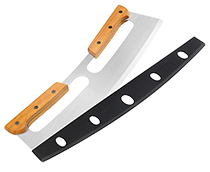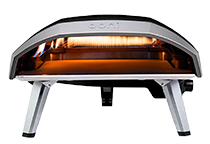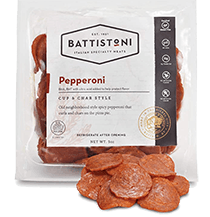Cleaning pizza cutters is an essential step in maintaining their sharpness and preventing the buildup of bacteria. These handy kitchen tools make it easy to slice through your favorite pies, but they can also become a breeding ground for germs if not cared for properly. In this article, we will explore the best methods for cleaning and maintaining your pizza cutter, ensuring its longevity and effectiveness.
Understanding the different types of pizza cutters and their distinct blade designs is crucial when it comes to properly cleaning and caring for these tools. Some cutters feature a wheel-like blade, while others have a rocking design. Each type requires specific cleaning techniques, which we will discuss further in the following sections.
Key Takeaways
- Proper cleaning and maintenance of pizza cutters is essential for their longevity and effectiveness.
- Understanding the different types of cutters and blade designs is crucial for proper cleaning techniques.
- Safety and maintenance tips can help prevent potential injuries and prolong the life of your pizza cutter.
Table of Contents
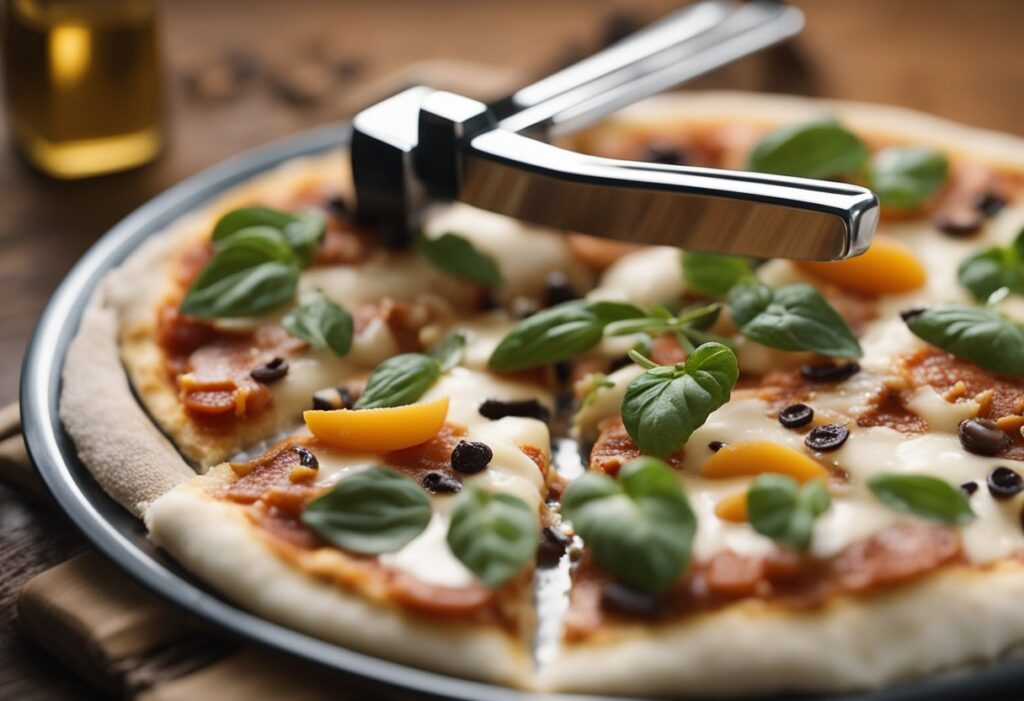
Understanding Pizza Cutters
As a pizza lover, I find it essential to know about the various types of pizza cutters and their unique designs. This helps me choose the appropriate cutter for different types of pizzas, whether it’s a thin-crust or a thick one.
The most common type of pizza cutter that I often use is the traditional wheel pizza cutter. It features a sharp, rotating wheel attached to a handle. The wheel’s size can vary, but it usually ranges from 3 to 4 inches in diameter. This design allows for easy cutting of the pizza by rolling the wheel over the surface. I’ve found it particularly useful for cutting pizzas fresh out of pizza ovens, as it ensures even slices with minimal effort.
Another type of pizza cutter is the mezzaluna, which has a curved blade and two handles on either end. I’ve noticed that its design allows for a rocking motion, which makes cutting through thicker crusts or those with lots of toppings easier. Mezzalunas come in various sizes, depending on the size and shape of the pizzas being cut.
Some unique designs of pizza cutters I’ve encountered include scissors and multi-blade cutters. Scissors are specially designed for cutting pizzas, usually with a flat, wide lower blade that slides under the pizza while the top blade cuts through it. Multi-blade cutters, on the other hand, have several parallel wheels that can cut multiple, evenly-spaced slices in one go, making them convenient for large gatherings.
I’ve found that understanding these different types of pizza cutters and their designs has improved my pizza cutting experience. Whether I’m using a traditional wheel cutter or a mezzaluna, knowing which type works best for a given pizza helps me achieve the perfect slices every time.

Choosing the Right Pizza Cutter
When it comes to slicing up a delicious pizza, having the right pizza cutter is essential. I’ve found that looking for a combination of size, quality, and comfort, while keeping an eye on budget, can make all the difference in achieving those perfect slices.
In my experience, a large and sharp blade, such as those found in OXO Good Grips Large Pizza Wheel or the Kitchy Pizza Cutter Wheel, can easily slice through various crust thicknesses, providing even slices. The 3.5-inch wheel of the KitchenAid Gourmet is another suitable option for medium to thin-crust pizzas.
Now, I know that price can be a concern for many of us. A budget-friendly choice, like the KitchenAid Classic Pizza Wheel, still delivers quality results at a wallet-friendly price. It’s essential not to compromise on the sharpness of the blade, as that could compromise the slicing quality.
When considering a pizza cutter, I’ve found that stainless steel blades tend to be durable, and many are dishwasher-safe, like the Rösle Stainless Steel Ergonomic Pizza Wheel. However, it’s prudent to hand-wash the pizza cutters with mild soap to prevent dulling the blade.
Comfort is also crucial when choosing a pizza cutter. Look for features like a non-slip grip and a comfortable handle to make slicing multiple pizzas a breeze. I’ve noticed that an ergonomic design, such as the one offered by the Rösle Stainless Steel Ergonomic Pizza Wheel, can provide comfort and stability while cutting.
In summary, when selecting the perfect pizza cutter, I focus on size, sharpness, material, price, and comfort to ensure I can effortlessly slice through any pizza and enjoy those delicious, even slices.
The Blades of Pizza Cutters

In my experience with pizza cutters, I have found that nearly all of them feature a sharp, stainless steel blade. This type of blade is not only durable, but also efficient in cutting through the pizza crust without making a mess.
When I look at the different types of pizza cutter blades, I notice that there are curved blades and flat blades. While both are generally effective for their intended purpose, I believe the curved blade allows for a better rocking motion, making it easier to cut through the toppings and crust. That being said, the choice between a curved or flat blade ultimately depends on personal preference.
Since a clean pizza cutter is crucial for maintaining hygiene and avoiding contamination, I always make it a point to clean the metal blade thoroughly after each use. One method I have found effective in removing stuck-on pizza debris is to soak the cutter in warm, soapy water for 30 minutes before wiping it down with a sponge or cloth. When needed, a denture tablet can be combined with water to create a cleaning solution that will help clean the blade even further.
In addition, it’s essential to keep the blade sharp. A dull blade can make cutting a challenge and may result in a damaged pizza or even injury. To maintain a sharp blade, I use a traditional knife sharpener with two or three stages of different grits, which helps achieve that perfect edge.
When it comes to the storage of my pizza cutter, I have come to realize that it’s not the best idea to leave it inside a kitchen drawer with other utensils. The blade may come into contact with other items, causing it to become scratched or jagged. To solve this issue, I use a magnetic bar or a wooden holder to store my pizza cutter with a blade cover.
Types of Pizza Cutters
When it comes to cutting pizza, there are several types of pizza cutters available, and choosing the right one often comes down to personal preference. In this section, I will discuss some of the most popular and useful pizza cutters.
One of the most well-known and widely used pizza cutters is the traditional wheel cutter, such as the OXO Good Grips pizza cutter. This type of cutter features a sharp wheel attached to a handle, making it easy to slice through various types of pizza crusts. I find that using a wheel cutter allows me to get clean cuts and easily navigate through different toppings.
An interesting and efficient alternative to the traditional wheel cutter is the rocking pizza cutter. This type of cutter features a long, curved blade that allows you to easily rock back and forth across the pizza to make quick and clean cuts. I like using a rocking cutter when I am working with larger pizzas, as it usually requires less effort and provides more control over the cutting process.
A more innovative option that has gained popularity in recent years is the pizza scissors. These specialized scissors are designed to easily cut through pizza crusts while keeping the toppings intact. I find pizza scissors to be incredibly easy to use, especially when dealing with thick crusts or multiple layers of toppings.
For those who enjoy a touch of whimsy in their kitchen gadgets, novelty pizza cutters are available as well. A popular example is the bicycle cutter, which resembles a vintage bicycle and has a cutting wheel as the front wheel of the bike. While I find these novelty cutters to be fun and unique, they may not always provide the most precise cuts or be the most practical option.
In conclusion, the type of pizza cutter one chooses is often a matter of personal preference. Factors such as ease of use, precision, and the types of pizzas being cut, as well as aesthetic considerations, may all play a role in making a decision. Regardless of the cutter selected, any of these options can help make pizza night a more enjoyable and efficient experience.
Cleaning Pizza Cutters
I always emphasize the importance of cleaning pizza cutters properly to ensure their longevity and to avoid any cross-contamination. The best approach to clean a pizza cutter is to hand wash it with mild soap and a sponge. Although some pizza cutters claim to be dishwasher-safe, I find it more effective to clean them by hand.
After using a pizza cutter, I quickly rinse it under running water to get rid of any remaining cheese or sauce. Then, I fill my sink with warm soapy water and gently scrub the cutter using a sponge. Paying attention to the blade and the area where it meets the handle is crucial since bits of food tend to get stuck in those areas.
If the cutter is still not completely clean or has stubborn residue, I use a neat trick to handle this situation. I place the pizza cutter in a bowl of water and add a denture tablet. Leaving it submerged until the tablet stops fizzing helps dissolve any stuck debris. Afterward, I give the cutter a thorough rinse, ensuring there are no soap or tablet residue left.
Sometimes, if I can’t clean the cutter immediately after using it, I submerge it in a bowl of soapy water for up to 30 minutes to prevent any food from drying out and becoming harder to remove later. However, I make sure not to soak the cutter for too long to avoid any potential rusting.
In summary, keeping a pizza cutter clean is simple and essential for its maintenance. Handwashing it with soapy water and using a denture tablet for stubborn residues are two straightforward methods I follow regularly. With these techniques, my pizza cutter remains in great condition, ready for the next pizza night.
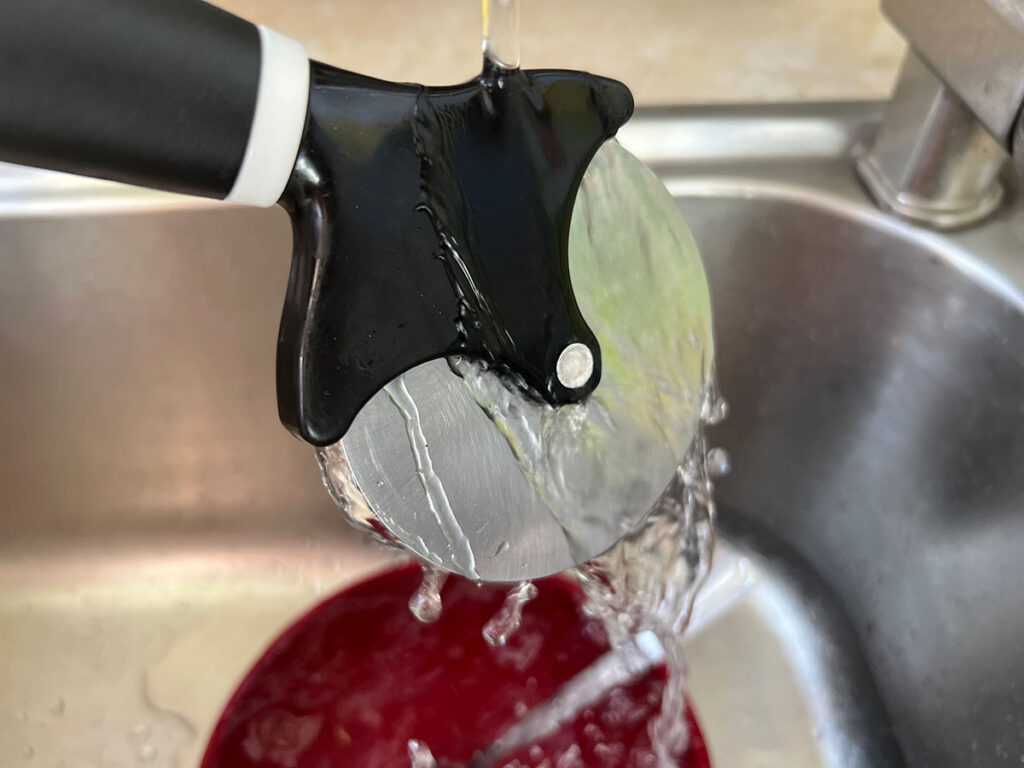
Preventing and Removing Rust
I have found that preventing rust on pizza cutters is essential since it not only prolongs their life but also ensures a safer and cleaner cutting experience. Stainless steel pizza cutters are less prone to rust and corrosion compared to other metals. However, they might still develop rust if not cared for properly.
One way to prevent rust is to make sure that the pizza cutter is dried thoroughly before storing it. After cleaning, I dry the pizza cutter with a clean towel or let it air dry. In addition, applying a small amount of cooking oil to the pizza cutter helps to prevent rust by creating a protective barrier on the surface. This is a simple yet effective method that I’ve used many times.
When it comes to removing rust from a pizza cutter, first, I scrub the rusted areas gently with fine steel wool or a soft brush. Being careful not to scratch the metal surface, I continue scrubbing until the rust is removed. Alternatively, soaking the pizza cutter in a solution of white vinegar and water (1:1 ratio) for 30 minutes to an hour can also help to dissolve the rust. Afterward, I rinse the cutter thoroughly with water and dry it properly before storing it in a safe and dry place.
By following these steps, I ensure that my pizza cutter remains rust-free and in optimal condition, making it ready for use whenever I crave a tasty pizza.
Pizza Cutter Safety and Maintenance Tips
I always prioritize safety when using and maintaining my pizza cutter. One essential safety feature to consider is a thumb guard, which helps protect my hand from accidental slips while cutting pizza. If my cutter doesn’t have a built-in thumb guard, I can purchase a separate blade cover to enhance safety during storage and handling.
Proper equipment maintenance is crucial for keeping my pizza cutter in excellent condition. After each use, I clean my cutter with warm soapy water, ensuring that any residue or grease is removed. Soaking the cutter in a cup of warm, soapy water for 30 minutes can help loosen stubborn debris. If needed, I use a soft brush to gently scrub off any stuck-on food or grease.
After cleaning, I take the time to properly dry my pizza cutter with a clean towel or let it air dry. To prevent rust, I apply a small amount of cooking oil to the pizza cutter, especially focusing on the blade and joints.
Keeping my pizza cutter sharp is also important for both safety and ease of use. I can use a knife sharpener to maintain the edge of the blade, but other options like a belt grinder can also be effective. The step-by-step guide on how to sharpen a pizza cutter can provide more detailed instructions if needed.
When storing my pizza cutter, I make sure it is safely placed in a drawer or hung on a wall mount to avoid potential accidents. By following these maintenance tips, I keep my pizza cutter in optimal condition and ensure a safe, enjoyable pizza cutting experience.
Tips for Cutting Various Types of Pizzas
As a pizza enthusiast, I’ve encountered various types of pizzas with diverse toppings and crust styles. To make your pizza cutting experience more manageable, let me share some tips I’ve learned along the way.
For thin-crust pizzas, like tortillas, glide the pizza cutter gently over the surface without applying too much pressure. A swift motion will help you achieve clean-cut slices without squishing the toppings.
When it comes to thick-crust pizzas such as Chicago-style pizza, you’ll need to apply more force to cut through the doughy layers. It’s essential to make sure your pizza cutter is sharp enough. In the case of frozen pizzas, you might want to let them thaw slightly before cutting to avoid damaging your cutter.
For focaccia and other rectangular or square-shaped pizzas, a pizza cutter might not be the ideal tool. In these situations, opt for a large sharp knife or even a pair of kitchen shears to cut through the crust and toppings evenly.
With tricky pizza recipes that come with an abundance of toppings, I find it beneficial to use a rocking motion when cutting. This technique prevents toppings from shifting or falling off the slice. You should also wait a few minutes after the pizza is out of the oven before cutting to allow the cheese to set, which further helps in maintaining the toppings’ placement.
Remember that there is no one-size-fits-all approach to cutting pizzas. You may need to adapt your cutting method depending on the type of crust, toppings, and even the pizza cutter. So, whether it’s a thin-crust margherita or a loaded thick-crust pizza, these tips should help you slice your way through any pizza with ease and confidence.
Using Pizza Cutters beyond Pizzas
In my experience, pizza cutters have proven to be versatile kitchen utensils that can be used for more than just slicing pizzas. Owning a good quality pizza cutter can help simplify many tasks in the kitchen.
For instance, pizza cutters can be used to cut tortillas into strips or quarters, perfect for baking or frying to create salad toppers or salsa dippers. Additionally, I have found them useful for cutting flatbread into even portions. These handy tools can also make quick work of dividing quesadillas into halves or quarters.
Another great use for pizza cutters is cutting ham steaks into cubes to add to soups or salads. This task can be accomplished much more efficiently than using a traditional knife. As the cutter glides smoothly through the meat, you can save both time and effort.
When serving various dishes, I’ve found that a pizza cutter can be helpful in slicing items like brownies, bars, or even pancakes. By using a pizza cutter, I ensure that my servings are evenly sliced without the risk of tearing or breaking my baked goods. It also makes for a more aesthetically pleasing presentation.
In summary, pizza cutters are more than just a one-trick pony. These essential kitchen utensils offer many alternative uses beyond pizza cutting and, in my opinion, should be a staple in every home cook’s toolbox. Whether it’s a Rösle, Winco, KitchenAid, or Checkered Chef Pizza Cutter, having a versatile and reliable tool is worth the investment.
Conclusion on how to clean pizza cutters
I’ve found that cleaning a pizza cutter is quite simple with the proper techniques. Taking apart the pizza cutter, if possible, is the easiest way to clean every component, including the blade and handle. The Kitchen Warriors provided some helpful steps to achieve a thoroughly cleaned pizza cutter without causing any damage to its parts.
In addition to cleaning, it’s important to sharpen the pizza cutter periodically. This ensures a smooth and efficient cutting experience. Using a sharpening stone or a whetstone requires some skill and patience, but the outcome is a sharp and functional pizza cutter, as explained by The Pizza Calc.
During the cleaning process, I recommend checking the inner parts of the handle attachment with a piece of white floss to ensure no residue is left behind. If needed, a denture tablet in a bowl of water can be a useful method to loosen any stubborn dirt.
To sum it up, routinely cleaning and sharpening the pizza cutter can lead to a safer and more enjoyable pizza cutting experience. By following the tips shared by various experts, I can confidently achieve a well-maintained pizza cutter and enjoy my delicious pizzas without any hassle.
Frequently Asked Questions
How do you remove rust from a pizza cutter?
If I notice rust on my pizza cutter, I would first try soaking it in a bowl of white vinegar for about 30 minutes. This helps to break down the rust and make it easier to remove. After soaking, I’d scrub the affected area gently with a soft cloth or sponge. Finally, I’d rinse the pizza cutter thoroughly and dry it completely to prevent further rusting.
I’ve found that the most important part is drying it afterwards. If you don’t dry it, the rust will just keeping coming back.
How do you maintain a pizza cutter?
To maintain my pizza cutter, I regularly clean it after each use by wiping the blade with a damp cloth or sponge and then drying it thoroughly. I store the cutter in a cool, dry place to reduce the risk of rust formation. Additionally, I periodically check for signs of rust or damage and address those issues as needed.
Is it safe to put a pizza cutter in the dishwasher?
While some pizza cutters may be dishwasher safe, I recommend checking the manufacturer’s instructions to ensure it is safe for your specific cutter. If dishwasher safe, I would place the pizza cutter on the top rack to avoid potential damage from high heat or water pressure.
What are some effective methods for cleaning a pizza cutter?
I find that soaking my pizza cutter in warm, soapy water for about 30 minutes is effective in removing food residue and grease. For stubborn stains, I can also use a denture tablet in a bowl of water and let it soak until the water stops fizzing. Then, I rinse it thoroughly and dry it completely.
How do you clean a pizza cutter wheel?
To clean the wheel of my pizza cutter, I use a soft brush or cloth to gently remove any food particles stuck in the crevices. If necessary, I may also run the wheel under warm water to loosen any remaining debris. After cleaning the wheel, I dry it thoroughly to avoid rusting.
What materials are safe to use when cleaning a pizza cutter?
When cleaning my pizza cutter, I prefer using soft materials such as sponges, cloths, or gentle brushes. Abrasive cleaners and scrubbing pads can damage the blade. In addition, I use mild dish soap and warm water to effectively remove food residue and grease. If needed, home remedies like white vinegar or denture tablets can also be utilized for more challenging cleaning tasks.

